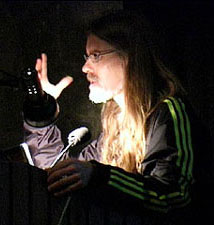You are here: Home > About > People > Sheldon Brown
Sheldon Brown

Professor of Visual Arts; Director of the Arthur C. Clarke Center for Human Imagination; Founder, New Media Arts for the California Institute of Telecommunications and Information Technologies (Calit2); University of California, San Diego
website
Sheldon Brown combines computer science research with vanguard cultural production. He is the Director of the Arthur C. Clarke Center for Human Imagination at UCSD where he is a Professor of Visual Arts and a co-founder of the California Institute of Telecommunications and Information Technologies (Calit2). He is the former Director of the Center for Research in Computing and the Arts (CRCA) and he is also the UCSD Site Director of the NSF supported Industry-University Collaborative Research Center for Hybrid Multicore Computing Research.
He has shown his work at: The Museum of Contemporary Art in Shanghai, The Exploratorium in San Francisco, Ars Electronica in Linz Austria, The Kitchen in NYC, Zacheta Gallery in Warsaw, Centro Nacional in Mexico City, Oi Futuro in Rio de Janeiro, Museum of Contemporary Art San Diego, and others. He has also been featured at leading edge techno-culture conferences such as Supercomputing, SIGGRAPH, TedX GDC and other conferences of leading edge techno-culture. He has been commissioned for public artworks in Seattle, San Francisco, San Diego and Mexico City, and has received grants from the NSF, AT&T New Experiments in Art and Technology, the NEA, IBM, Intel, Sun Microsystems, SEGA SAMMY, Sony, Vicon and others.
Highlighted project
The Scalable City is a multi-user virtual world involving users, data and algorithms as applied to urban development. As our world becomes increasingly characterized by this equation, we find ourselves inhabiting the artifacts of these relationships. The Scalable City places responsibility for this on each of its users; their activities are simultaneously constructive and destructive. This work poetically draws analogies through mis-application of computational processes to design decisions and how development in general can produce unintended effects after much iteration. Users experience this as their movements shape the interactions of major components of the world. Users each control a vortex of automobiles, which continually spews copies of itself into the atmosphere. As this vortex moves through the landscape, it causes roads to “grow”. Scattered throughout the landscape are architectural fragments. This junk is flung into the air by the car tornados and the pieces then try to reform back into houses. As they do so, they produce shanty-like facsimiles of their original form, which will be scattered again when another car vortex passes by. The Scalable City attenuates the experience of our presence in the world as a process of transformation, promoting awareness of how tools and attitudes can become systems that perpetuate their own logic rather then that of long-term benefit.
Work environment and institutional setting
Sheldon runs an NSF- and Industry-supported center at UCSD that creates new methods for utilizing parallel computing processes for next-generation digital media. This is located within the California Institute of Information Technology and Telecommunications – for which Sheldon was one of the Co-PIs. CRCA has a New Media Arts wing of about 9000 sq. ft. of advanced digital media production facilities including 4K stereo digital cinema, a 15-sided CAVE, multiple VR environments, a 10-sided CineChamber, a motion capture lab, 24.4 channel surround sound studio, a rapid protoyping and CNC production lab, 3D laser scanning, a 300 megapixel display wall, and more. Sheldon collaborates with cognitive scientists and science fiction authors in his work.